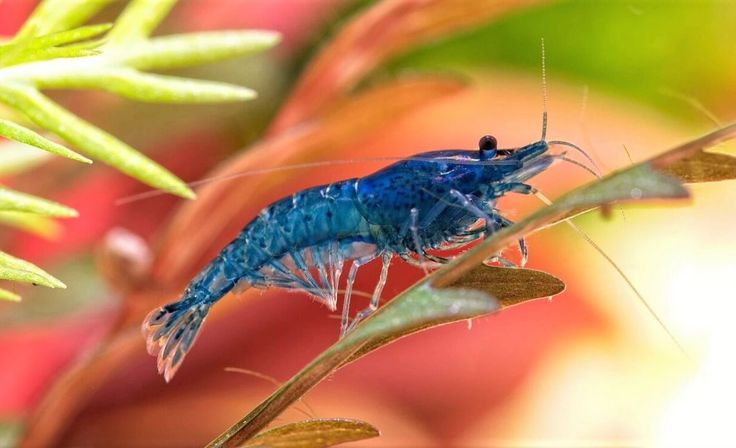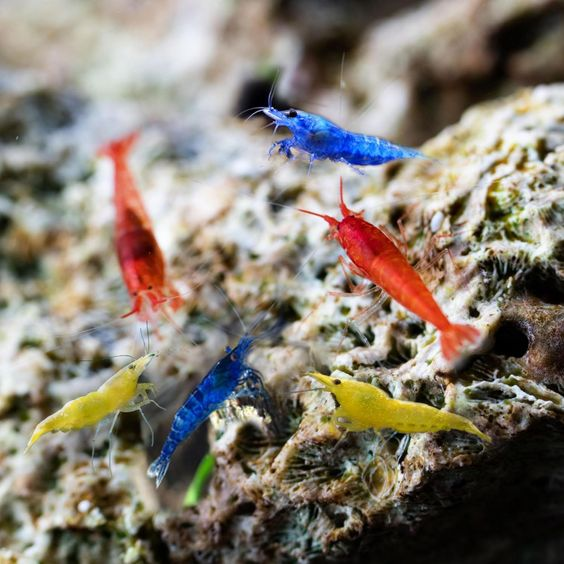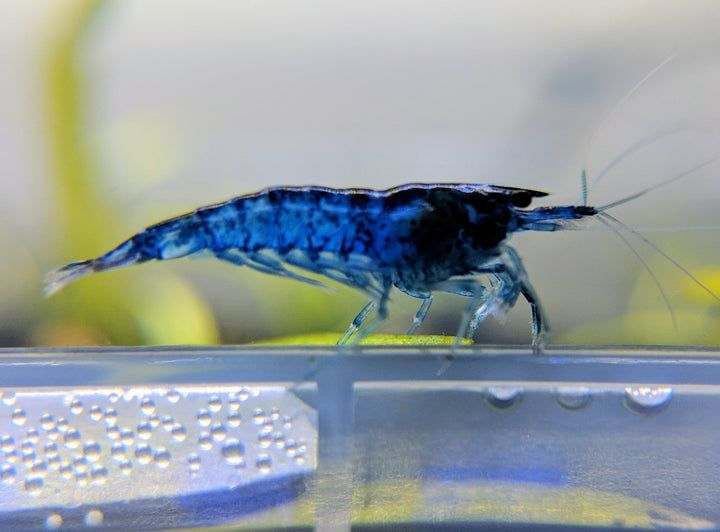Use these Blue Dream shrimp care tips in this guide to teach you everything from feeding and tank setups to breeding and health care!

Introduction
Don’t you just love acquiring uniquely colored freshwater shrimps and making your tank the envy of all eyes? Well, we absolutely do, and that’s why we’re here today to offer you helpful guidelines on how to care for this outstanding Neocaridina species!
The Blue Dream shrimp is truly one of a kind. Its unique color pattern is bound to steal gazes and cause conversations.
These Blue Neocaridina shrimp are native to the clear streams and rivers of Eastern China and Northern Taiwan and have, over the years, graced millions of home aquariums and tanks with their dark blue transparent bodies featuring varying intensities that make some Blue Dream shrimp appear almost black.
With an adult size of 1.2 inches (3cm), the Blue Dream shrimp’s appearance, peaceful nature, and friendliness with other small species make it the perfect candidate for any community tank. Now that your interest has been peaked let’s thoroughly explore the details in the guide to keep these vibrant aquarium shrimp healthy and kicking in your tank!
Setting Up The Ideal Tank for Blue Dream Shrimp

So, you took the cue and purchased a Blue Dream shrimp for yourself, and now you’re wondering how to create the ideal shrimp tank setup for these blue beauties; don’t fret; help is right here!
The first thing to consider when setting up a shrimp tank is getting the right size to help your shrimp swim comfortably and stay active. The minimum tank size for a group of Blue Dream Shrimp is 5-6 gallons, which means 2-4 adult shrimp per ½ gallon (1 liter) of water.
Next on the Blue Dream shrimp tank setup list is ensuring stable and optimal water conditions for shrimp survival. How do you do this?
- You must maintain a water temperature range of 68-78oF to lower stress and the risk of disease for your shrimp.
- Keep the pH level of your water between 6.5 and 8.
- Ammonia and nitrite levels should be 0 ppm with less than 20 ppm nitrate levels.
- Add sponge filters to ensure water oxygenation with gentle water flow to keep your tank fresh and clean.
The last thing to note is adding some decor, like plants and smooth pebbles, to provide natural hiding spots during the breeding season and shelter when fatigued. Opt for a dark substrate when creating the best freshwater shrimp tank conditions to enhance color contrast and aesthetic appeal.
Feeding Blue Dream Shrimp: A Nutritional Guide for Vibrant Color

Are you looking for the best shrimp diet tips? We’ve got some for you!
The dietary needs of the average Blue Dream shrimp often revolve around a balanced nutritional supply of algae wafers, shrimp-specific pellets, and occasional blanched vegetables such as spinach, broccoli, carrots, and cabbage. They’re omnivores with a broad diet, including scavenging other dead shrimp or fish.
Feeding Blue Dream shrimp a balanced diet can improve their color intensity (which plays a vital role in their popularity among aquarists) and overall health, including breeding and swimming strength.
Feeding Tips
- One thing to always avoid while feeding your shrimp aquarium is overfeeding. How do you ensure this? It’s easy! Keep the frequency between 1-2 times a day with only enough food that can be completely eaten within 3-5 minutes.
- A bonus of keeping this shrimp is that the Blue Dream shrimp feed on biofilm in their tanks. This means you can provide ample surface area for biofilm to grow and ease the load of frequent feeding off your hardworking shoulders.
- They also clean up the tank by consuming waste and leftover food. These extra qualities help keep your community aquariums clean.
For more on feeding your aquatic pets check out The Ultimate Guide to Fish Food: Pros and Cons & Best Choices!
Breeding Blue Dream Shrimp: Step-by-Step Guide

Blue Dream shrimp are versatile breeders with refreshing hardiness that can work in any environment; however, because of the fragility of these eggs and the significance of Neocaridina shrimp reproduction to Blue Dream shrimp’s survival, it’s best to maintain stable water conditions and a healthy diet.
When the saddled female wants to mate, pheromones are released, enticing the males to begin the search for a female to mate.
This video has been very helpful in identifying the sex of Neocaridina Shrimp, I highly recommend it:
The fertilization process starts with the male shrimp releasing sperm onto the female; the berried shrimp carrying between 20-30 eggs perform regular fanning to ensure fresh water moves over the eggs to keep them clean and well-oxygenated.
Blue Dream shrimplets hatch between 25-35 weeks after fertilization and immediately begin to act like adult shrimp and source their food.
Freshwater shrimp breeding tips
- Keep the pH level and temperature as indicated above stable.
- Berried female shrimp should be fed a protein-rich diet to promote egg survival and help hatch healthy shrimplets.
- Provide hiding spots during Blue Dream shrimp breeding so shrimplets can retreat during the first few weeks of their lives.
Ideal Tank Mates for Blue Dream Shrimp

As explained earlier, Blue Dream shrimp are highly tolerant and social animals that can survive with other peaceful aquarium species if they’re small enough, consume a similar diet, and will not prey on them. Compatible fish for shrimp tanks that can be introduced to your Blue Dream shrimp tank include small tetras, rasboras, and other Neocaridina shrimp.
Larger, predatory, or aggressive fish like Angelfish, Oscar Fish, or even Goldfish might kill, hunt, or harass your shrimp, causing them stress or death, are not suitable as Blue Dream shrimp tank mates.
Preventing Health Issues in Blue Dream Shrimp

Understand the best freshwater shrimp care by identifying common shrimp diseases and how to treat them in this section.
Molting
Causes: Poor water and food quality (absence of calcium in diet)
Symptoms: Deformed/incomplete molt, reduced motion in tank
Treatment: Maintain stable water conditions and increase calcium supply in their diet.
Sensitivity to copper
Causes: Excess copper in tap water added to the tank
Symptoms: Lethargy, erratic swimming
Treatment: Avoid using products with copper, regular water changes, and testing water parameters to discover imbalances quickly.
Bacterial Infection
Causes: High organic waste in the tank
Symptoms: Lethargy, white patches on the body, poor color intensity
Treatments: Improve water quality, clean/replace substrate, and introduce bacterial treatment to water.
Blue Dream shrimp health tips
- Test your water parameters regularly
- A balanced diet for your shrimp boosts their immune health which helps in preventing shrimp illnesses.
- Shrimp are very sensitive to treatments, so make sure to administer invertebrate-specific medication.
Maximizing the Lifespan of Blue Dream Shrimp
Want some tips on shrimp care for a long life? Say less!
The average Blue Dream shrimp lifespan is 1-2 years, and influences from a well-balanced diet, high water quality, and a low-stress environment directly impact the shrimp.
If you intend to extend the longevity of your freshwater shrimp, regular tank maintenance, which includes consistent water changes, monitoring water temperature and pH level closely, keeping ammonia, nitrate, and nitrite levels low at all times, and infusing vegetables and foods rich in protein, are vital.
Conclusion
Who’s ready to become a pro Blue Dream shrimp keeper after digesting this guide’s beginner shrimp tips guide? You!
The stunning blue hue of this aquarium shrimp is truly a pacesetter in any tank, coupled with their easy care regimen and suitability for both beginner and expert shrimp hobbyists. But no matter your experience level, knowing the right way to conduct freshwater shrimp maintenance will determine the successful outcome of your efforts.
Our final word to you is to fully utilize the knowledge shared in this Blue Dream shrimp care guide to your advantage. We have addressed most of your concerns and answered your questions about keeping Blue Dream shrimp, but you should keep learning to care for your shrimp.


